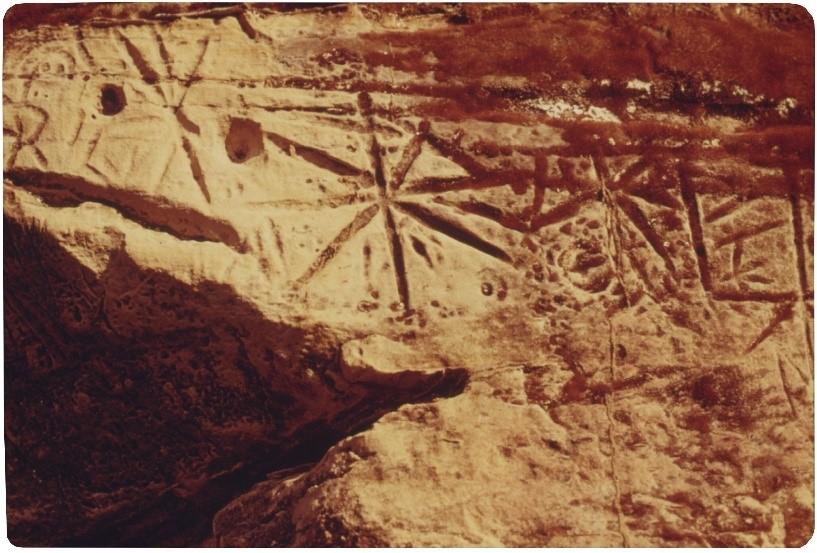Created by Madison Yurich on Thu, 04/25/2024 - 22:03
Description:
This is an image of a Native American petroglyph, one that is specifically mentioned in the journal of the Lewis and Clark Expedition. This petroglyph was carved on a limestone cliff near the Nemaha River in Troy, Kansas (“Pictographs, Petroglyphs”). According to Clark on February 21, 1805, he had received information that a few Native American men would be leaving their camp to consult the Medicine Stone, in order to determine predictions regarding the upcoming year. Clark mentions that the Native American people believed very deeply in the stone and that every spring they visited the stone to see what it would tell them about the future. He wrote, “They haveing arrived at the Stone give it Smoke and proceed to the wood at Some distance to Sleep--- the next morning return to the Stone, and find marks white & raised on the Stone representing the piece or war which they are to meet with, and other changes, which they are to meet" (“Journals”), to explain the process of how the stone predicted the reality of each upcoming year. Clark even commented on the stone by saying, “This Stone has a leavel Surface of about 20 feet in Surcumfrance, thick [NB: thick] and pores, and no doubt has Some mineral qualtites effected by the Sun” (“Journals”), to describe its appearance.
From what is known about petroglyphs and pictographs today, there is evidence to suggest that their purpose was to incorporate and reveal mythological and religious practices and beliefs. In North America, there are two terms used to describe these devices. The word “Kekeewin” is representative of something that is “generally understood by the tribe,” and “Kekeenowin,” which are teachings by priests and prophets (“Pictographs”). Therefore, the knowledge of the meanings of many of these petroglyphs and pictographs can only be understood by those who had a collective cultural knowledge of them. This means that there was an importance placed on pictographic communication amongst the Native Americans within their tribes, even though this importance might not have been understood by the white people of the time (Klotz 193). As mentioned above, it also reinforces the importance of culture and religion, and these pictographs and petroglyphs offered the Native Americans a way to pass down their traditions in the form of written/visual communication and participate in cultural practices, such as using these petroglyphs to make predictions about the future.
Works Cited
“Journals of the Lewis & Clark Expedition.” February 21, 1805 | Journals of the Lewis and Clark Expedition, lewisandclarkjournals.unl.edu/item/lc.jrn.1805-02-21#lc.jrn.1805-02-21.01. Accessed 17 Apr. 2024.
Klotz, Sarah. “Pictograph as Epitaph: Reading Algonquian Pictography in the Removal Period.” Early American Literature, vol. 55, no. 1, Jan. 2020, pp. 177–207. EBSCOhost, https://doi.org/10.1353/eal.2020.0008.
“Pictographs of the North American Indians.” Pictographs of the North American Indians, by Garrick Mallery-The Project Gutenberg eBook, www.gutenberg.org/files/54643/54643-h/54643-h.htm. Accessed 17 Apr. 2024.
“Pictographs, Petroglyphs, ‘Rock Art,’ What Is the Difference?” National Archives and Records Administration, National Archives and Records Administration, prologue.blogs.archives.gov/2019/10/14/pictographs-petroglyphs-rock-art-what-is-the-difference/. Accessed 17 Apr. 2024.


